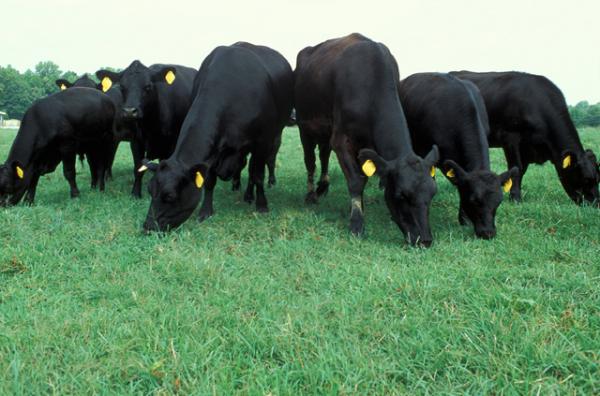
Agricultural News
Performance Analysis Program Shows What Reduces Cow Costs and Increases Revenue
Fri, 28 Dec 2012 10:16:36 CST

Property taxes don't mind if your cows are black or white or red. Ranches must have fences, pickups and equipment, regardless of what the calves weigh at weaning.
"Fixed cost doesn't care whether you've got 400 cows, 200 cows, 60 cows or 2 cows. It's going to be the same," says Stan Bevers, Texas A & M University beef economist. "The only way to drive down the impact is to get more cows."
As the industry anxiously awaits a drought reversal and herd rebuilding, many experts say now is the time to analyze overall carrying expenses.
"One of the problems that we run into is that guys don't calculate their cow costs, so things get out of perspective," says Jim McGrann, emeritus ranch management economist at Texas A & M. "They will try to save in areas where it's not going to make that big of a difference."
McGrann implemented the management program know as Standardized Performance Analysis (SPA) in the 1990s, to help producers benchmark their herd against others. Bevers now manages that program, which shows an average annual cost of $590.85 for a cow in 2012.
"I started in 1989. Then, the average cost was about a dollar per day, so we haven't quite doubled, but it's getting close," he says.
Each year, he adds, the largest components are labor, management, depreciation and feed.
It's important to keep vehicle and equipment cost in check, McGrann says. "But everything else is more of a question of execution of a good plan and watching how they spend their money."
A key is keeping a focus on reproduction.
"Cost control is more closely related to making sure they don't hurt reproduction," he says. "For example, if they don't feed right, they are going to hurt reproduction. If they don't get high calf crops relative to their exposed females, they can never have a low cost operation."
Scott Brown, University of Missouri ag economist, points to a tool developed by colleague Brent Carpenter that is designed to help determine what one could pay for a female.
"Losing a calf in one of her first three or four years reduces what you should pay for her by more than $600," he says, noting that predictable calving-ease genetics may provide some risk protection.
"If you're not a cost-effective producer, you're not going to be in business regardless," Brown says. "But many of those costs you don't have much control over because of your cow choice. I think there is a lot more gain to be had on the revenue side than the expense side."
When rain comes, the decisions made in the rebuilding process could have a huge impact on future production.
"Really the market is telling you that you have to have cattle that will grade and yield and be taken to a pretty heavy weight," McGrann says.
That all starts with genetics, and better bulls come with a higher price tag. But McGrann says that shouldn't scare a producer.
"When I'm purchasing a bull, it will have an economic life of anywhere from three to five years," he says. "When you put it in the proper perspective-what does it means in terms of depreciation per female serviced-it's really a low cost number."
A $3,100 bull servicing 25 cows per year for 5 years averages out to a $45.49 annual service cost per cow exposed. That' just 7.6% of total cow costs. Spend another $400 on a bull and that number increases less than $4, at 8.2% of total cow costs. Increasing by $1,000 to buy the bull for $4,100 would figure out to a $55.29 service charge, or 9.2% of cow costs.
That's holding everything else equal. What if those genetics are more expensive because they're more reliable, more efficient or help cut costs in other ways?
Looking at the revenue side helps prove the value.
"What's it really mean if I get another 10 or 20 pounds of weaning weight on those calves?" Brown asks. In terms of cow costs, the Missouri calculator says you could pay $175 more for a cow if she weans 20-lb. heavier calves.
"The chance to improve genetics in your herd should be something that everyone is looking at," Brown says. In his definition, that would fall into several categories: mothering ability and calving ease, growth and carcass quality.
"Bulls that are going to have maternal traits would be a big piece of that," says James Henderson, of Bradley 3 Ranch in the lower Texas panhandle. The seedstock Angus breeder has been focused on a cow that works in the mesquite brush environmental they call home.
Structural soundness is a bare minimum, but after that he suggests commercial Angus producers look at benchmarking tools like the SPA program they've participated in since its inception, as well as recent advancements like the GeneMax DNA test from Certified Angus Beef.
"We've found that our high marbling cattle are our easiest keeping cattle," Henderson says. "I think marbling may be a more valuable reproductive trait than it is a carcass trait."
When he hears people assigning a negative correlation to the two, he wonders if they're confusing marbling and milk.
"In the Angus breed, there are a lot of high-marbling cattle that are also high milk-it's pretty easy to misread which one of those traits is costing you money," he says. "High-milk cows are going to be much more expensive to maintain and rebreed, but high-marbling cows, in my experience, are the ones that survive in tough times."
McGrann says the records don't dispute that: "I've probably done as much individual producer analysis as anybody in the country, from a business perspective, and I've found no relationship between quality of the calf and cost of production."
WebReadyTM Powered by WireReady® NSI
Top Agricultural News
More Headlines...



















